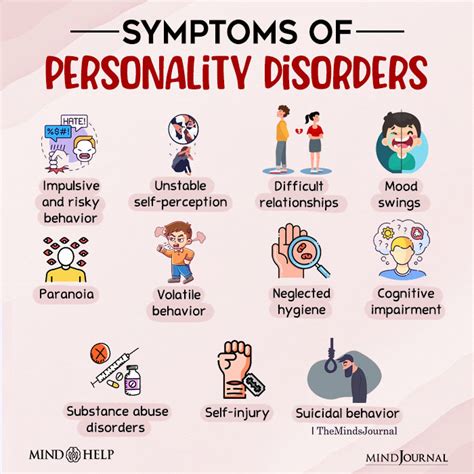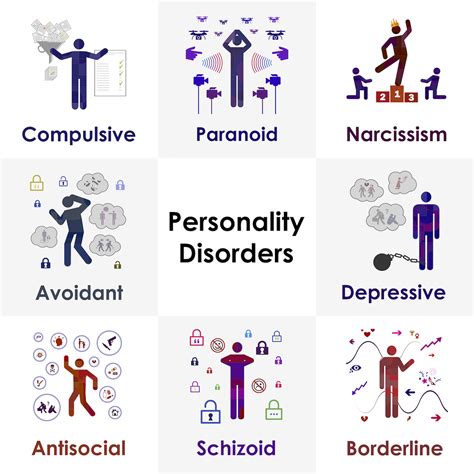Intro
Personality disorders are complex and multifaceted mental health conditions that affect an individual's thoughts, feelings, and behaviors. They are characterized by persistent and maladaptive patterns of behavior, cognition, and emotional regulation that deviate from cultural norms and expectations. Understanding personality disorders is crucial for developing effective treatment strategies, improving mental health outcomes, and enhancing overall well-being.

What are Personality Disorders?
Personality disorders are a group of mental health conditions that are characterized by enduring and inflexible patterns of behavior, cognition, and emotional regulation. These patterns are often maladaptive and lead to significant distress, impairment, and difficulties in interpersonal relationships. According to the Diagnostic and Statistical Manual of Mental Disorders (DSM-5), there are 10 distinct personality disorders, each with its unique set of diagnostic criteria and characteristics.
Types of Personality Disorders
- Borderline Personality Disorder (BPD): Characterized by unstable relationships, emotional dysregulation, and impulsivity.
- Narcissistic Personality Disorder (NPD): Marked by grandiosity, a need for admiration, and a lack of empathy.
- Antisocial Personality Disorder (ASPD): Characterized by a disregard for others' rights, lack of empathy, and impulsivity.
- Avoidant Personality Disorder (AVPD): Marked by social anxiety, avoidance of social interactions, and feelings of inadequacy.
- Obsessive-Compulsive Personality Disorder (OCPD): Characterized by a need for control, perfectionism, and rigidity.
- Histrionic Personality Disorder (HPD): Marked by excessive emotionality, attention-seeking behavior, and a need for approval.
- Schizoid Personality Disorder (SPD): Characterized by social isolation, apathy, and a lack of emotional expression.
- Schizotypal Personality Disorder (STPD): Marked by eccentric behavior, social anxiety, and a lack of close relationships.
- Paranoid Personality Disorder (PPD): Characterized by mistrust, suspiciousness, and a tendency to perceive threats.
- Dependent Personality Disorder (DPD): Marked by a need for others to take responsibility, lack of self-confidence, and clingy behavior.
Causes and Risk Factors
The exact causes of personality disorders are still not fully understood, but research suggests that a combination of genetic, environmental, and social factors contribute to their development. Some of the risk factors include:
- Genetics: Family history of personality disorders or other mental health conditions.
- Childhood trauma: Physical or emotional abuse, neglect, or instability.
- Brain chemistry: Imbalances in neurotransmitters, such as serotonin and dopamine.
- Social and cultural factors: Cultural norms, social isolation, and lack of social support.

Symptoms and Diagnosis
The symptoms of personality disorders vary depending on the specific disorder, but common characteristics include:
- Maladaptive behavior patterns: Inflexible and persistent patterns of behavior that lead to distress and impairment.
- Emotional dysregulation: Difficulty managing emotions, leading to mood swings, anxiety, or depression.
- Impaired relationships: Difficulty forming and maintaining healthy relationships due to trust issues, emotional instability, or manipulative behavior.
Diagnosis is typically made through a comprehensive evaluation, including:
- Clinical interviews: A thorough assessment of symptoms, behavior patterns, and medical history.
- Psychological assessments: Standardized questionnaires and rating scales to evaluate personality traits and symptoms.
- Observation: Observation of behavior and interactions with others.
Treatment and Management
Treatment for personality disorders typically involves a combination of psychotherapy, medication, and lifestyle changes. The goals of treatment include:
- Symptom reduction: Managing symptoms and reducing distress.
- Behavioral change: Developing more adaptive coping mechanisms and behavior patterns.
- Improved relationships: Enhancing interpersonal relationships and social skills.
Some effective treatment approaches include:
- Cognitive-behavioral therapy (CBT): A problem-focused approach to identify and challenge negative thought patterns and behaviors.
- Dialectical behavior therapy (DBT): A skills-based approach to develop emotional regulation, distress tolerance, and interpersonal effectiveness.
- Psychodynamic therapy: An exploratory approach to understand and address underlying conflicts and emotional struggles.

Conclusion
Personality disorders are complex and multifaceted mental health conditions that require a comprehensive understanding and approach. By recognizing the signs and symptoms, understanding the causes and risk factors, and seeking effective treatment, individuals can develop more adaptive coping mechanisms, improve their relationships, and enhance their overall well-being.
If you or someone you know is struggling with a personality disorder, it is essential to seek professional help from a qualified mental health professional. With the right treatment and support, it is possible to manage symptoms, develop more adaptive behavior patterns, and improve overall mental health outcomes.
What is the difference between a personality disorder and a mental illness?
+A personality disorder is a type of mental health condition that is characterized by persistent and maladaptive patterns of behavior, cognition, and emotional regulation. A mental illness, on the other hand, is a broader term that encompasses a range of conditions, including mood disorders, anxiety disorders, and psychotic disorders.
Can personality disorders be cured?
+While personality disorders cannot be "cured" in the classical sense, treatment can help individuals develop more adaptive coping mechanisms, improve their relationships, and enhance their overall well-being. With the right treatment and support, individuals can learn to manage their symptoms and improve their quality of life.
How can I help someone with a personality disorder?
+Helping someone with a personality disorder requires empathy, understanding, and patience. It is essential to encourage the individual to seek professional help and support their treatment plan. Additionally, educating yourself about personality disorders and their effects can help you better understand and respond to the individual's needs.
